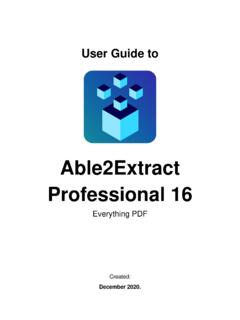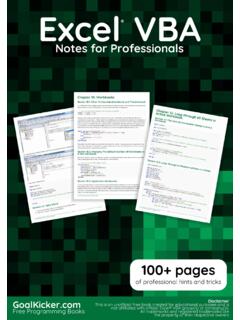Transcription of PLANE DIP and STRIKE, LINEATION PLUNGE and TREND ...
1 1 PLANE DIP and STRIKE, LINEATION PLUNGE and TREND , PLANE DIP and STRIKE, LINEATION PLUNGE and TREND , STRUCTURAL MEASURMENT CONVENTIONS, THE BRUNTON STRUCTURAL MEASURMENT CONVENTIONS, THE BRUNTON COMPASS, FIELD BOOK, and NJGS FMSCOMPASS, FIELD BOOK, and NJGS FMSR ider Structural Geology 310 2012 GCHERMANS ources:Lisle, R. J., 2004, Geological Structures and Maps, A Practical Guide, Third DRIVE/Rider/ word azimuthstems from an Arabic word meaning "direction , and means an angular measurement in a spherical coordinate system. In structural geology, we primarily deal with land navigation and directional readings on two-dimensional maps of the Earth surface, and azimuth commonly refers to incremental measures in a circular (0- 360 ) and horizontal reference frame relative to land Pocket Transit2 Bedding and other geological layers and planes that are not horizontal are said to dip.
2 The dip is the slope of a geological surface. There are two aspects to the dip of a PLANE :(a) the direction of dip, which is the compass direction towards which the PLANE slopes; and(b) the angle of dip, which is the angle that the PLANE makes with a horizontal PLANE (Fig. ).The direction of dip can be visualized as the direction in which water would flow if poured onto the PLANE . The angle of dip is an angle between 0 (for horizontal planes) and 90 (for vertical planes). To record the dip of a PLANE all that is needed are two numbers; the angle of dip followed by the direction (or azimuth) of dip, 74/138 is a PLANE which dips 74 in the direction 138 . PLANE Dip and Linear PlungePlane Dip and Linear PlungeddddooooDip = ddddoooohorizontalRider Structural Geology 310 2012 GCHERMAN3 Any dipping PLANE can be thought of as containing a largenumber of lines of varying PLUNGE (Fig.)
3 The strike line is a non-plunging or horizontal line within a dipping PLANE . The line numbered 5 in is an example of a strike line; it is not the only one but the other strike lines are all parallel to it. If we think of the sloping roof of a house as a dipping PLANE , the lines of the ridge and the eaves are equivalent to strike PLUNGE and TrendLinear PLUNGE and TrendPlunge is used to describe the tilt of lines, the word dip being reserved for planes. The PLUNGE fully expresses the three-dimensional orientation of a line and has two parts:(a) the angle of PLUNGE , and(b) the PLUNGE direction or the plunging line on the dipping PLANE to the right and an imaginary vertical PLANE containing the plunging PLUNGE direction is the direction in which this vertical PLANE runs, and is the direction towards which the line is tilted. The angle of PLUNGE is the amount of tilt; it is the angle, measured in the vertical PLANE , that the plunging line makes with the horizontal.
4 The angle of PLUNGE of a horizontal line is 0 and the angle of PLUNGE of a vertical line is 90 . TrendRider Structural Geology 310 2012 GCHERMAN4 Within a dipping PLANE the line at right angles to the strike line is the line with the steepest PLUNGE . The angle of PLUNGE of the steepest plunging line in a PLANE is equal to the angle of dip of that PLANE . A strike line is not a polar line (with a unique azimuth), but can be recorded using supplementary angles. For example, the PLANE to the right is striking E and/or W. Strike and dip angles are measured using a few different techniques. We will focus on two: PLANE Strike and Dip, and Recording ConventionsPlane Strike and Dip, and Recording Conventions1. Dip and dip azimuth (0-90 /(0-359 ), and2. Strike (0-179 ), Dip, and Dip Direction (N,E,S,W) The PLANE in the example is dipping due south, thatis recorded either as 45/180 (using method 1 or 090/45 S for method 2.))
5 The dip azimuth and strike are always complimentary. Two other recording conventions for PLANE strike and dip that you may encounter include the quadrant, and the right-hand rule. For the planes sketched above, strike and dip using the quadrant method would be recorded as N90E/45 S. The quadrant system is popular in the US and primarily uses a primary north (N) or south (S) reference, with a secondary direction (E or W). Appended after the bearing. The right-hand rule method requires a unique strike direction (or a polar line), one that has the dip direction lying to the right (clockwise). So for a PLANE dipping 45 South, the PLANE recorded using the right-hand rule is 090/45 S. A PLANE dipping 45 North would be 270/45 N using the same Structural Geology 310 2012 GCHERMAN5 Recording Conventions and Notebook/Computer NotationRecording Conventions and Notebook/Computer NotationWhen using the Strike, Dip, and Dip Direction convention for recording planes, only measure and record strike azimuth in the 0-179 range, writing strike 1rst, dip 2nd, and dip direction 3rd, in sequence.
6 This helps keep planar readings separate from LINEATION readings in your field book, and minimizes confusion over what type of feature was recorded that may arise later upon revisiting your notes. Here is a example of some structural measurements:TYPE OF FEATURE ABBREVIATION FOLLOWED BY STRUCTURAL READINGB 123/45 S J 090/23 N SP 123/66 N SL 66/033 FA 13/002 J 040/88 NPlanes: B - bedding, J - joint, SP shear PLANE LINEATION : SL - slip LINEATION , FA fold axis4 planes and 2 LINEATION are recorded above. Notice how the planes have a three-digit/two-digit format and the LINEATION have a two-digit/three-digit format. Also, planes have the alphabet modifier whereas a LINEATION doesn strike in the field with a pocket compass is easier than measuring dip azimuth. But the dip azimuth convention is needed when manipulating and using your data with computers.
7 You choose what system you prefer to record your measurements. Ultimately, the system should be easiest for you to remember and use. However, it is expected of you to be able to convert all different methods to one Structural Geology 310 2012 GCHERMAN6 The Brunton CompassThe Brunton CompassWe will be using a Brunton compass to collect field measurements. A Brunton compass, properly known as the Brunton Pocket Transit, is a precision compass made by Brunton, Inc. of Riverton, Wyoming. It was patented in 1894 by David W. Brunton, a Canadian-born Colorado geologist. The Brunton (for short) utilizes magnetic induction damping rather than fluid to damp needle oscillation. The Brunton Pocket Transit is a specialized instrument used widely by geologists, archaeologists, environmental engineers, and surveyors to make accurate degree and angle measurements in the field.
8 The United States Army has adopted the Pocket Transit as the M2 Compass for use by crew-served Structural Geology 310 2012 GCHERMAN7 The Earth is completely surrounded by a magnetic field, and an unobstructed magnetized object will orient itself with the planets magnetic north and south poles. Magnetic declination (variation) is the difference between true geographic north (north pole) and magnetic north (in northern Canada), with respect to your position. It is important to note magnetic declination at your position, because magnetic declination varies and fluctuate slowly at different rates, around the world. An example of a map legend showing the declination of Magnetic North from True North, and the manual procedure for adjusting the compass for magnetic declinationThe Brunton CompassThe Brunton CompassRider Structural Geology 310 2012 GCHERMAN8 Sometimes, it is more convenient to use a different method when measuring the orientation of a line on a PLANE rather than the TREND and PLUNGE .
9 Occasions arise on the outcrop where accessibility factors make it difficult to position oneself properly in order to take a TREND reading, or the dip of the PLANE is to steep and makes TREND measurement impractical. The orientation of the line on a dipping PLANE can also be defined by the pitchof the line. Pitch is synonymous with the US term rake. The pitch(rake) of a line is the angle measured in the PLANE between the strike line and the line of interest. A strike sense direction must also be given to indicate which of the two possible strike senses was used. The orientation of the PLANE also must be given in order to uniquely orient the line. Pitch angles are in the range 0-90o, with a pitch of 0obeing a line parallel to the strike, and a pitch of 90obeing a line parallel to the dip line. Line Rake (or Pitch) on a PlaneLine Rake (or Pitch) on a PlaneDiagrams illustrating strike, dip, TREND , PLUNGE , and the angle of rake that a line makes on a dipping PLANE .
10 Figure modified from Principles of Structural Geology by John Suppe, 1985. LINEATION rakes 45oEon fault PLANE 125/60N Slip directionThe Colorado School of Mine provides a free Excel application for converting pitch on a PLANE to linear PLUNGE / TREND . See FLASH DRIVE/ FMS automatically converts values upon data entry in the Structural Geology 310 2012 GCHERMAN9 You will be recording your field observations, notes and structural readings in a field book that is supplied at the beginning of class. This will be your ledger of activity in the field and laboratory. It will be reviewed but not graded. What you transpose from it will be graded, so it is vital that you keep your observations, notes, thoughts, and readings organized and legible for later reference. It is advisable to use an indelible marker to personalize you book inside the font hard cover in case it is ever misplaced or forgotten.




